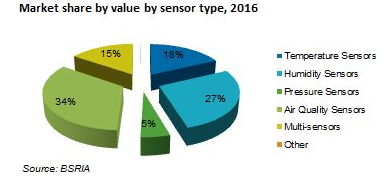BACS market in North America
The BSRIA BACS North America – In-Depth Report reveals that sales of BACS products (Building Automation and Control Systems) was US$ 1,970 million in 2016, an increase of 2.5% on 2015, while total installed systems sales was US$ 5,801 million.
The total value of service and maintenance was US$ 2,475 million, pushing the total value of BACS business in 2016 to US$ 8,276 million.
Zoltan Karpathy, Manager – Intelligent Buildings and Homes, BSRIA, said: “The main factors driving market growth have been the uptake of data analytics and concern over energy costs.
BACS forecast sales trend (2017-2021), US$ millions
The general performance trend of the BACS industry has been closely related to the USA’s and Canada’s economy and construction. As USA’s BACS market accounts for 86% of North America, the effect of the USA is much stronger than that of Canada. So, looking at the overall picture, Canada’s slowdown in the last two years is less visible.
USA rebounded strongly from 2010, where recession and annual growth of the economy has generally oscillated within the range of 2-3%.
Non-residential construction had a slight decrease in 2014 (-0.4%) but recovered strongly with growth rates within the range of 7-8% in 2015 and 2016.
Market share by value by sensor type, 2016
Overall, in the total market, the main drivers of growth are refurbishment and retrofit (not new construction) which benefit from a continued interest to invest in energy saving HVAC system upgrades. The US BACS market had cautious spending in 2016 due to the presidential election.
The value of DDC controllers was US$ 812 million, of which 63% are field level controllers; their share has been growing faster than the sometimes overcomplicated automation controllers.
Currently the controller market is dominated by the top five manufacturers, Honeywell, Johnson Controls, Siemens, Trane and Schneider Electric.
BACS historical sales trend (2011-2016), US$ millions
Zoltan said: “In terms of value, air-quality type (including CO2) is the most popular type of sensor in North America, accounting for 34% by value. This trend is due to the emphasis placed by companies on healthy living and increased productivity. Also it is policy driven as most states mandate legislation for air quality in schools and universities.”
A major trend is to add energy data analytics (Building energy management systems - BEMS) to existing BACS solutions, which continues to support retrofit/refurbishment sales, allowing BACS systems previously working in isolation to be integrated with other applications via open communication protocols.
Zoltan continued: “With the building automation segment continuing to grow in North America, there is an incentive for new players to enter the market in order to gain a share of this expanding business. This process is reinforced by the increasing trend towards integration of building automation and controls with other areas of smart technology, such as cloud-based monitoring management and smart homes. As one of the world’s largest markets for building automation, North America is a natural target for such activities.”
Market share by project type, 2013 & 2016
The purpose of the study was to provide a detailed quantitative and qualitative assessment of the current and future markets for intelligent control systems in non-residential buildings in North America.
For more information see BSRIA Market Intelligence.
--BSRIA
[edit] Related articles on Designing Buildings Wiki
Featured articles and news
CIOB and CORBON combine forces
To elevate professional standards in Nigeria’s construction industry.
Amendment to the GB Energy Bill welcomed by ECA
Move prevents nationally-owned energy company from investing in solar panels produced by modern slavery.
Gregor Harvie argues that AI is state-sanctioned theft of IP.
Heat pumps, vehicle chargers and heating appliances must be sold with smart functionality.
Experimental AI housing target help for councils
Experimental AI could help councils meet housing targets by digitising records.
New-style degrees set for reformed ARB accreditation
Following the ARB Tomorrow's Architects competency outcomes for Architects.
BSRIA Occupant Wellbeing survey BOW
Occupant satisfaction and wellbeing tool inc. physical environment, indoor facilities, functionality and accessibility.
Preserving, waterproofing and decorating buildings.
Many resources for visitors aswell as new features for members.
Using technology to empower communities
The Community data platform; capturing the DNA of a place and fostering participation, for better design.
Heat pump and wind turbine sound calculations for PDRs
MCS publish updated sound calculation standards for permitted development installations.
Homes England creates largest housing-led site in the North
Successful, 34 hectare land acquisition with the residential allocation now completed.
Scottish apprenticeship training proposals
General support although better accountability and transparency is sought.
The history of building regulations
A story of belated action in response to crisis.
Moisture, fire safety and emerging trends in living walls
How wet is your wall?
Current policy explained and newly published consultation by the UK and Welsh Governments.
British architecture 1919–39. Book review.
Conservation of listed prefabs in Moseley.
Energy industry calls for urgent reform.






























